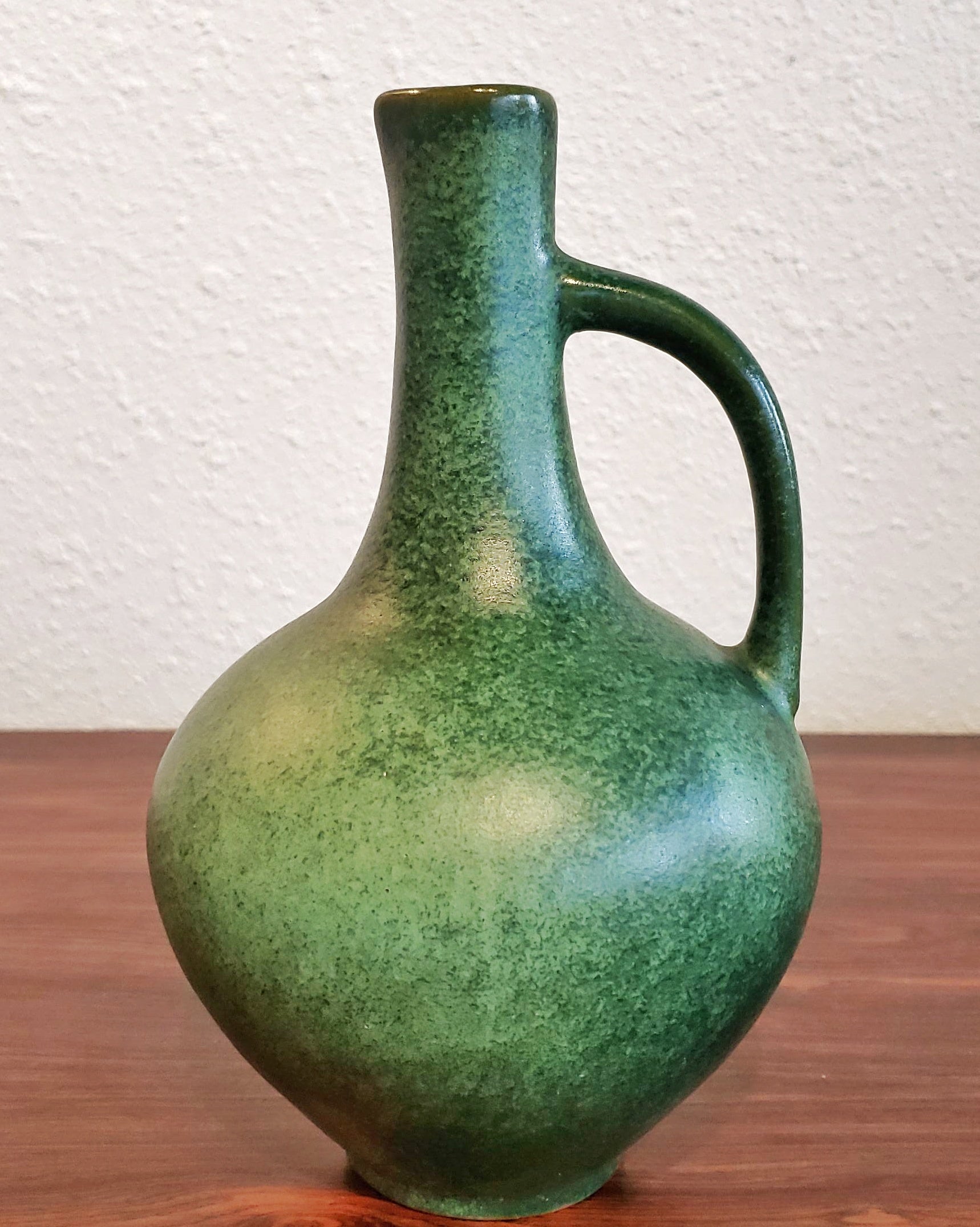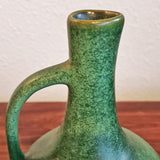








FRIEDGARD GLATZLE FOR KARLSRUHE MAJOLIKA Nr. 6403
CONTACT US HERE ABOUT THIS ITEM.
A beautiful mottled green ewer vase designed by Friedgard Glatzle for the majolika factory in Karlsruhe, Germany. The lines are classic and the forest green glaze is perfectly modern to compliment the form of the vessel.
MAJOLIKA KARLSRUHE (more formally, Staatliche Majolika Manufaktur Karlsruhe) was organized at Karlsruhe in southwest Germany in 1901 when Grand Duke Friedrich I agreed to build a ceramics factory at the behest of German pictorial artists Wilhelm Süs and Hans Thoma. Their goal was to revive the so-called "majolica" or faience technique, where opaque, tin-based glazes were applied to earthenware to serve as the basis for colored decoration. (The tin glaze used in majolica is actually a lead glaze that has been rendered white and opaque by the addition of tin oxide. In the production process, unglazed articles are first fired in a kiln and then dipped in the tin glaze, which is allowed to dry. Designs are then painted on the glaze, which sets them off and preserves them during a second, high-temperature firing.) Towards the end of the decade, a signature style of majolica had developed: compositions, often including cherubim, on a blue background.
The pottery passed through various hands in the following years, at one time being occupied by Villeroy & Boch, with the premises being owned by the state of Baden. (In 1927 the word 'Staatliche' was added to the name to indicate state ownership.) Despite the specificity of its name, MAJOLIKA KARLSRUHE produced a wide range of artisan ceramics and was one of Germany's leading producers of ceramics generally. The quality of production was excellent. Top designers prior to WWII included Ludwig König and Max Läuger.
The factory was badly damaged by bombs in 1944 and did not return to the full-time production of decorative goods until the 1950's, when business resumed much as in pre-war days, with both company-employed and freelance designers. One of the foremost post-war designers was Friedegart Glatzle, who joined MAJOLIKA KARLSRUHE in 1951, and who over the next 30 years produced a huge range of designs. Other designers of note during this period included luminaries Eva Fritz-Lindner and Werner Meschede. To this day the company provides artists with their own studio space and commissions work from them. Product examples can be seen at the Badisches Landesmuseum in Karlsruhe.
Most MAJOLIKA KARLSRUHE pieces bear the company's name and symbol—the arms of Baden above a double-joined 'M' for Majolika-Manufaktur. Items are made with a red-orange clay and are marked with a form number.
FRIDEGART GLATZLE (B.1920) received her high school diploma in 1940 and went on to attend the Werkschule Albrecht Leo Merz in Stuttgart from 1946 to 1947. After her apprenticeship as a potter from 1947 to 1949 in the Hinz pottery in Leinfelden, she passed her journeyman’s examination in Stuttgart in 1950 while studying at the technical school for ceramics in Höhr-Grenzhausen, from which she subsequently graduated in 1951. She was employed by the State Majolica Manufactory in Karlsruhe that same year and, with over 1200 mold designs, decisively determined the appearance of series production there over the following three decades. In addition, she created an extensive studio collection of hand-glazed works, including numerous unique pieces.
| Designer | FRIDEGARD GLATZLE |
|---|---|
| Manufacturer | Karlsruher Majolika |
| Design Period | 1960 to 1969 |
| Production Period | Unknown |
| Country of Manufacture | Germany |
| Identifying Marks | This piece has an attribution mark |
| Style | Vintage, Mid-Century, Minimalist, Modernist |
| Detailed Condition | Excellent — This vintage piece is in near original condition. It may show minimal traces of use and/or have slight restorations. |
| Product Code | |
| Materials | Ceramic |
| Color | Forest green |
| Width | 4.5 inch |
| Depth | 4.5 inch |
| Height | 7.8 inch |









